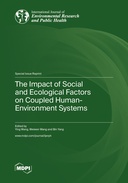Explore

The Impact of Social and Ecological Factors on Coupled Human-Environment Systems
0 Ungluers have
Faved this Work
Login to Fave
The relationship between human beings and the ecological environment poses a significant global challenge for the present and the future. As human–environment interactions become more complex, it is essential to measure and understand the spatiotemporal dynamics of coupled human–environment systems and how they are influenced by social and ecological factors. This reprint offers twenty original research articles that explore the latest developments in monitoring and projecting the spatiotemporal changes of the coupled system, examining the responses of the coupled system to socio-ecological drivers and processes, and discussing the implications for the sustainable management of the coupled system.
This book is included in DOAB.
Why read this book? Have your say.
You must be logged in to comment.
Rights Information
Are you the author or publisher of this work? If so, you can claim it as yours by registering as an Unglue.it rights holder.Downloads
This work has been downloaded 68 times via unglue.it ebook links.
- 68 - pdf (CC BY) at Unglue.it.
Keywords
- arable land protection behavior
- behavioral intervention
- Beijing-Tianjin-Hebei urban agglomeration
- Biology, Life Sciences
- carbon emission
- carbon emissions
- China
- community farmers
- county level
- coupling coordination
- coupling coordination degree
- driving factors
- Driving-Pressure-State-Impact-Response (DPSIR) model
- eco-efficiency of land use
- Ecological science, the Biosphere
- ecological security pattern
- Ecosystem services
- ecosystem services value
- ecosystem services’ value (ESV)
- Evaluation
- excessive demand
- factors allocation
- flood adaptation
- formation mechanism
- geographic probe
- Gini coefficient
- grain-planting industry
- green economic efficiency
- green infrastructure
- Guanzhong Plain Urban Agglomeration
- Guiyang City
- habitat quality
- Hanjiang River Basin (HRB)
- Huanggang Dabieshan UNESCO Global Geopark (UGGp)
- human activity intensity
- human well-being
- impact mechanism
- improvement pathways
- influencing factors
- interactive response
- InVEST
- InVEST model
- land market
- land reallocation intentions
- land use intensity
- land-use change
- land-use simulation
- landscape pattern
- Life sciences: general issues
- Lower Yellow River
- main function zone
- Mathematics & science
- Modernization
- mountainous cities
- neighborhood effect
- net carbon sequestration
- nudging strategies
- objective built environment
- obstacle analysis
- perceived built environment
- place attachment
- production-living-ecological space
- production–living–ecological spaces
- Reference, information & interdisciplinary subjects
- Research & information: general
- resilient city
- rice–crayfish integrated system
- rural community resilience
- rural revitalization
- rural revitalization demonstration area
- SCS-CN model
- Shennongjia National Park
- Situational Analysis
- slacks analysis
- spatial and temporal variation
- spatial autocorrelation
- spatial correlations
- spatial priority evaluation
- spatial regression
- spatiotemporal characteristics
- structural equation model
- Super SBM-DEA model
- technology adoption
- territorial space
- territorial space planning
- the middle reaches of Yangtze River
- thema EDItEUR::G Reference, Information and Interdisciplinary subjects::GP Research and information: general
- thema EDItEUR::P Mathematics and Science::PS Biology, life sciences
- thema EDItEUR::P Mathematics and Science::PS Biology, life sciences::PSA Life sciences: general issues::PSAF Ecological science, the Biosphere
- theoretical discussion
- TOPSIS model
- tourism ecological security
- ucl
- urban block
- Urban ecosystem services
- urban land development intensity
- urban land use efficiency
- Urbanization
- Wuhan
- Yangtze River economic belt (YREB)
- Yellow River Basin
Links
DOI: 10.3390/books978-3-0365-7653-4Editions

